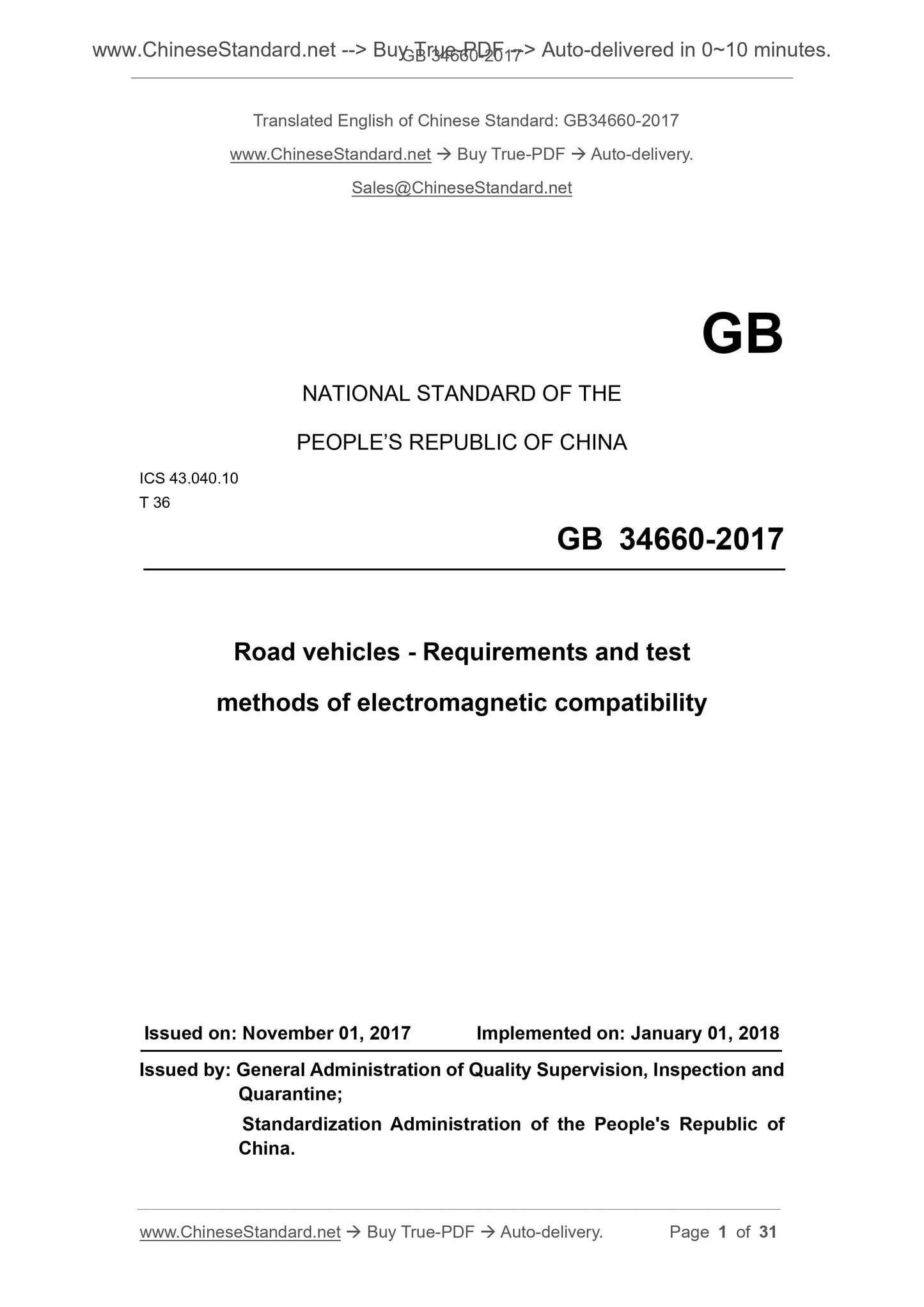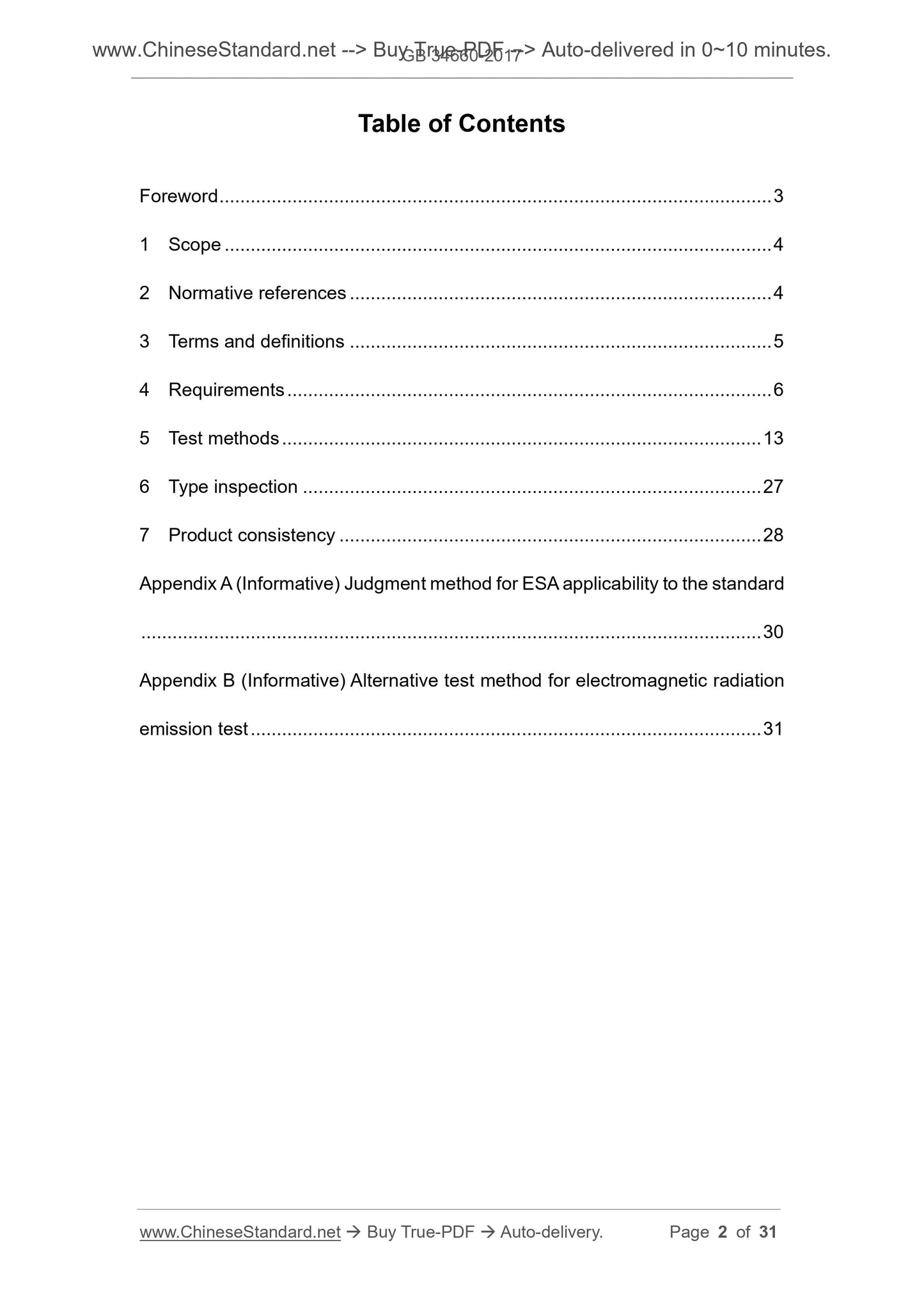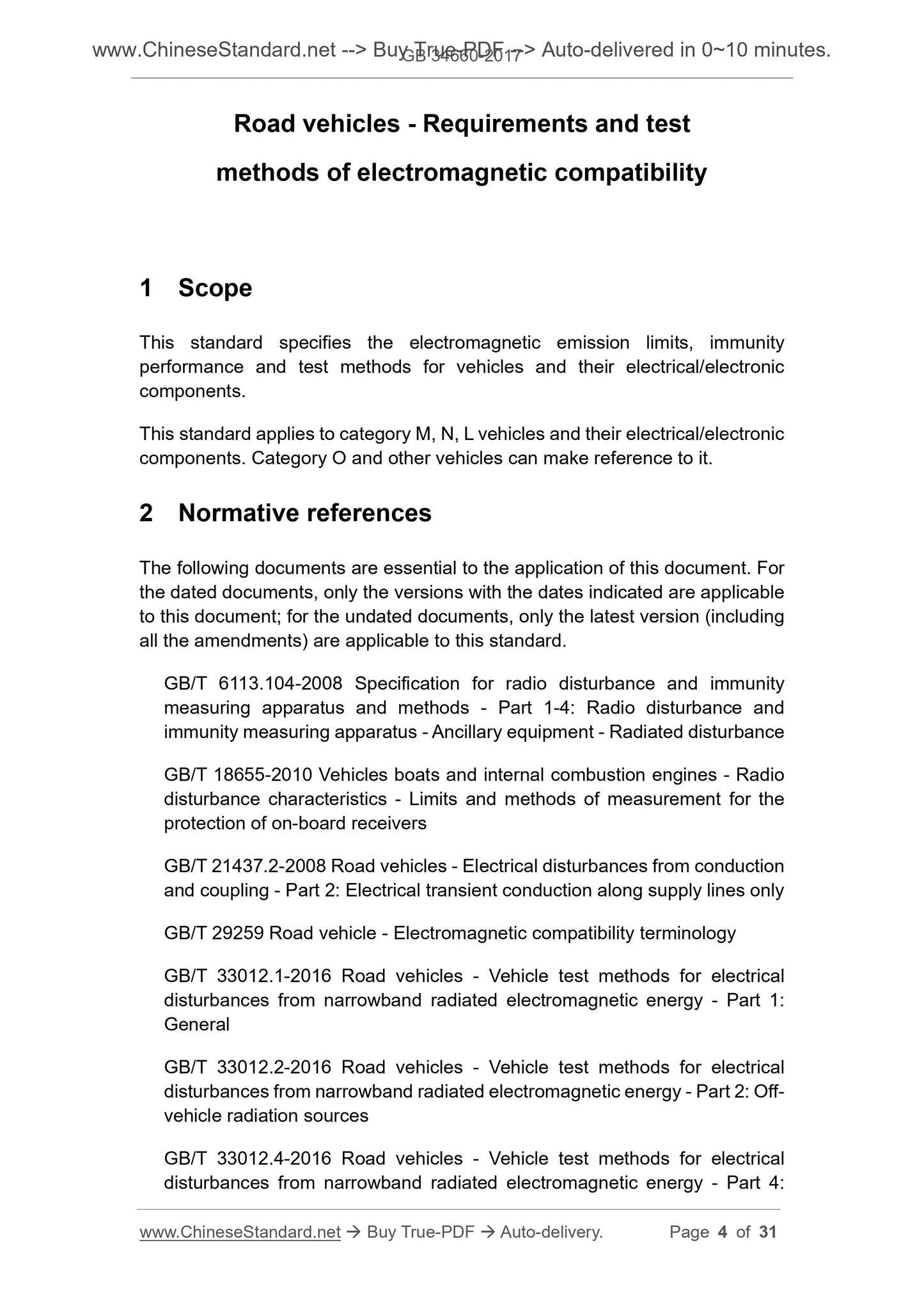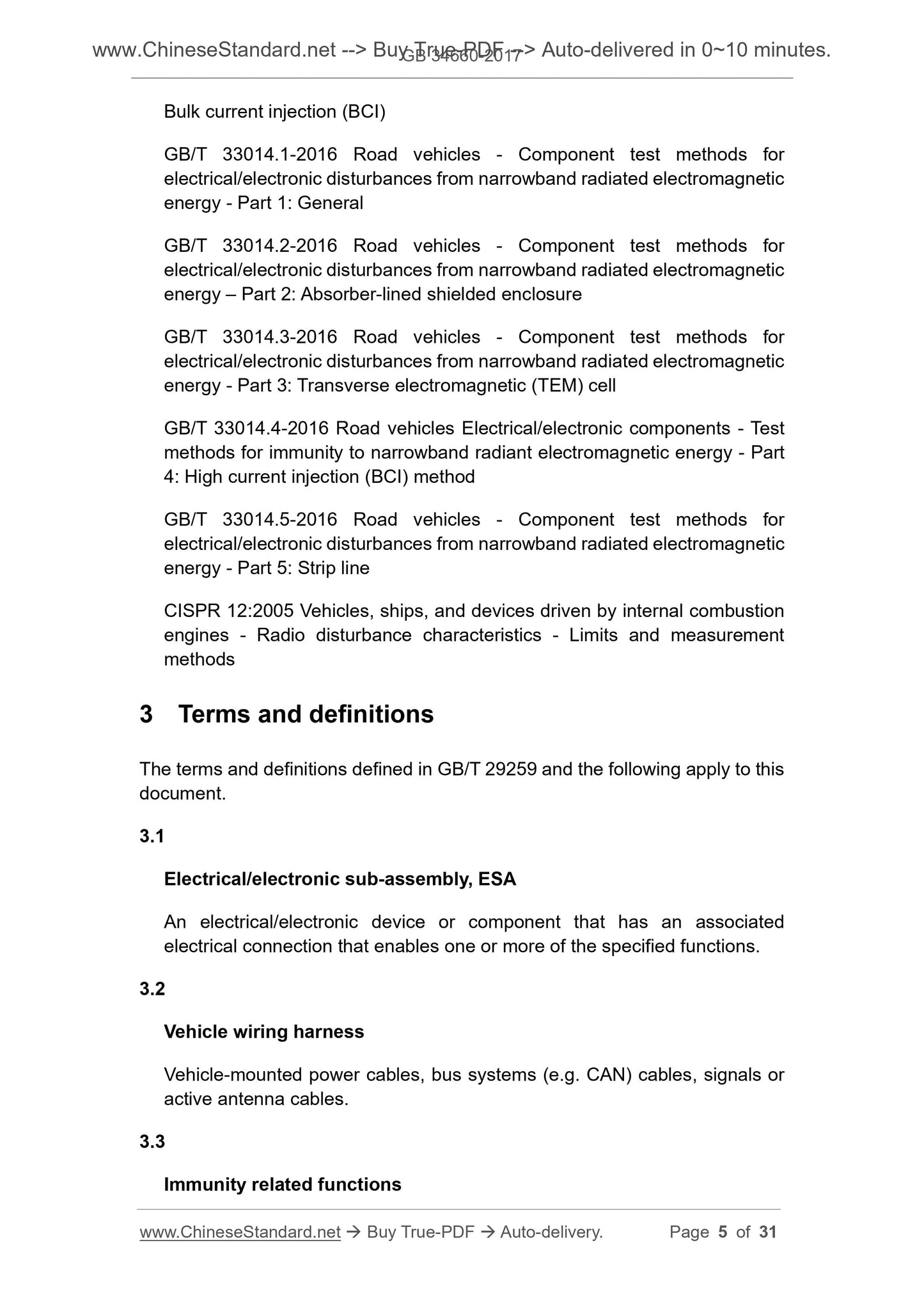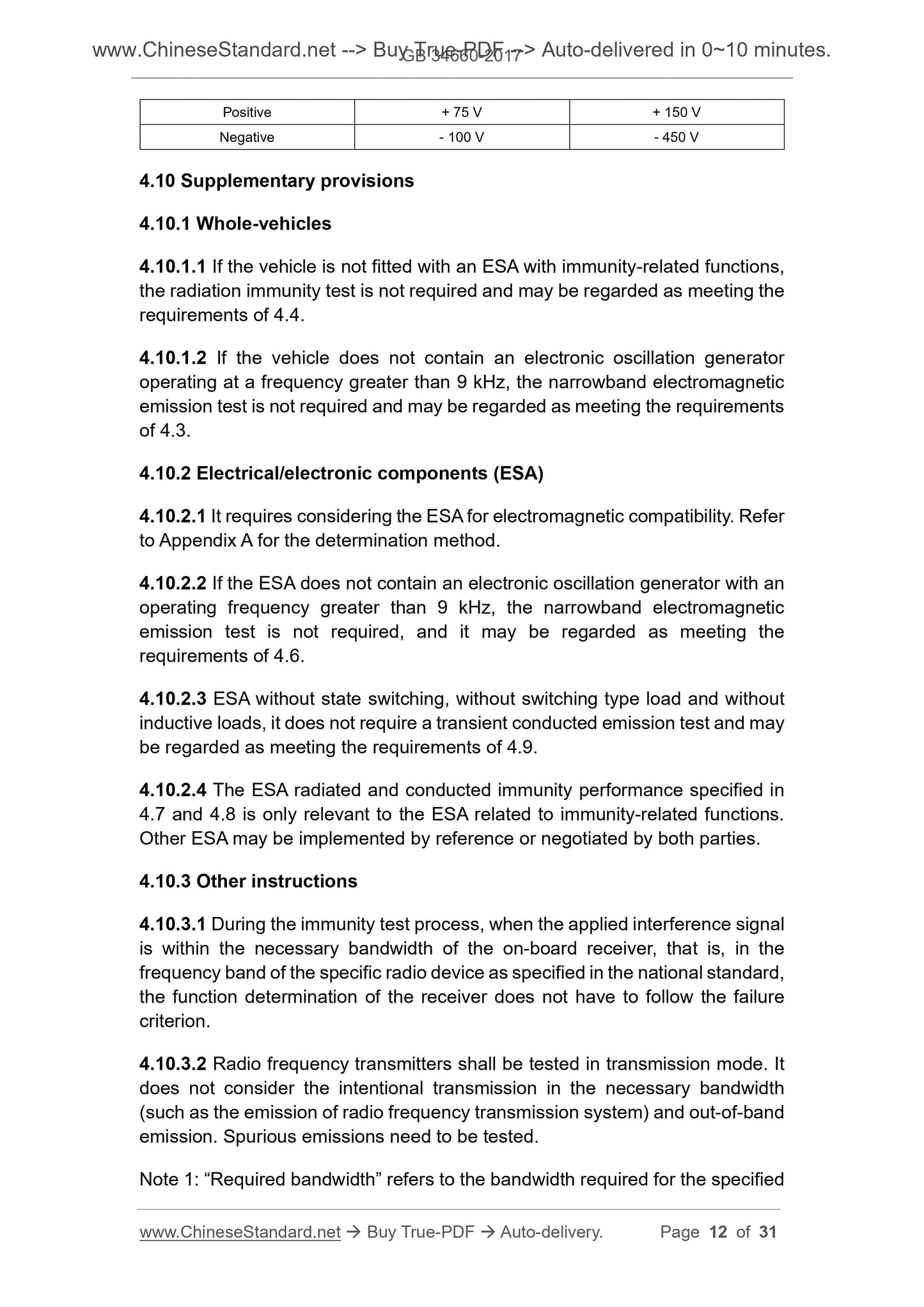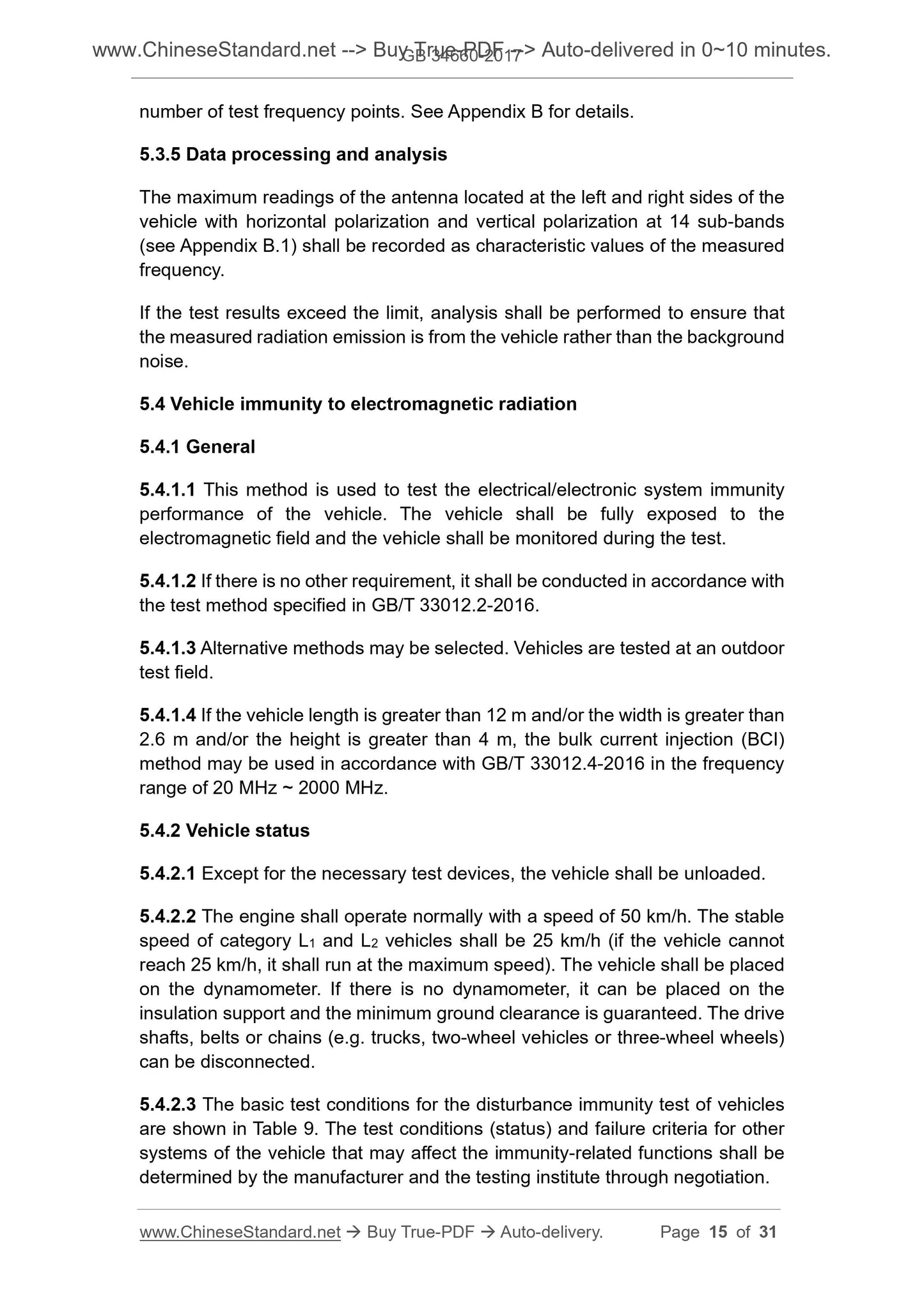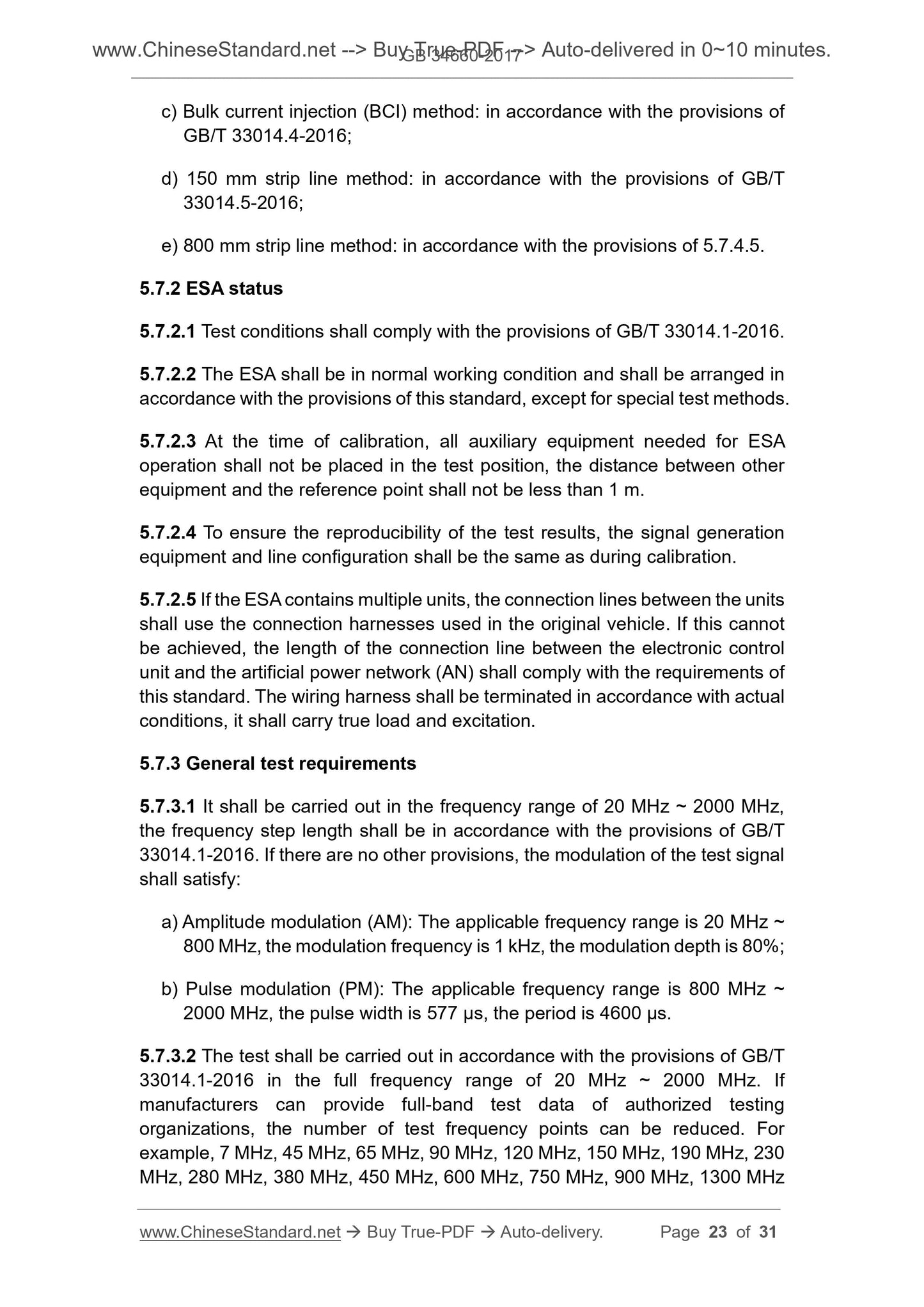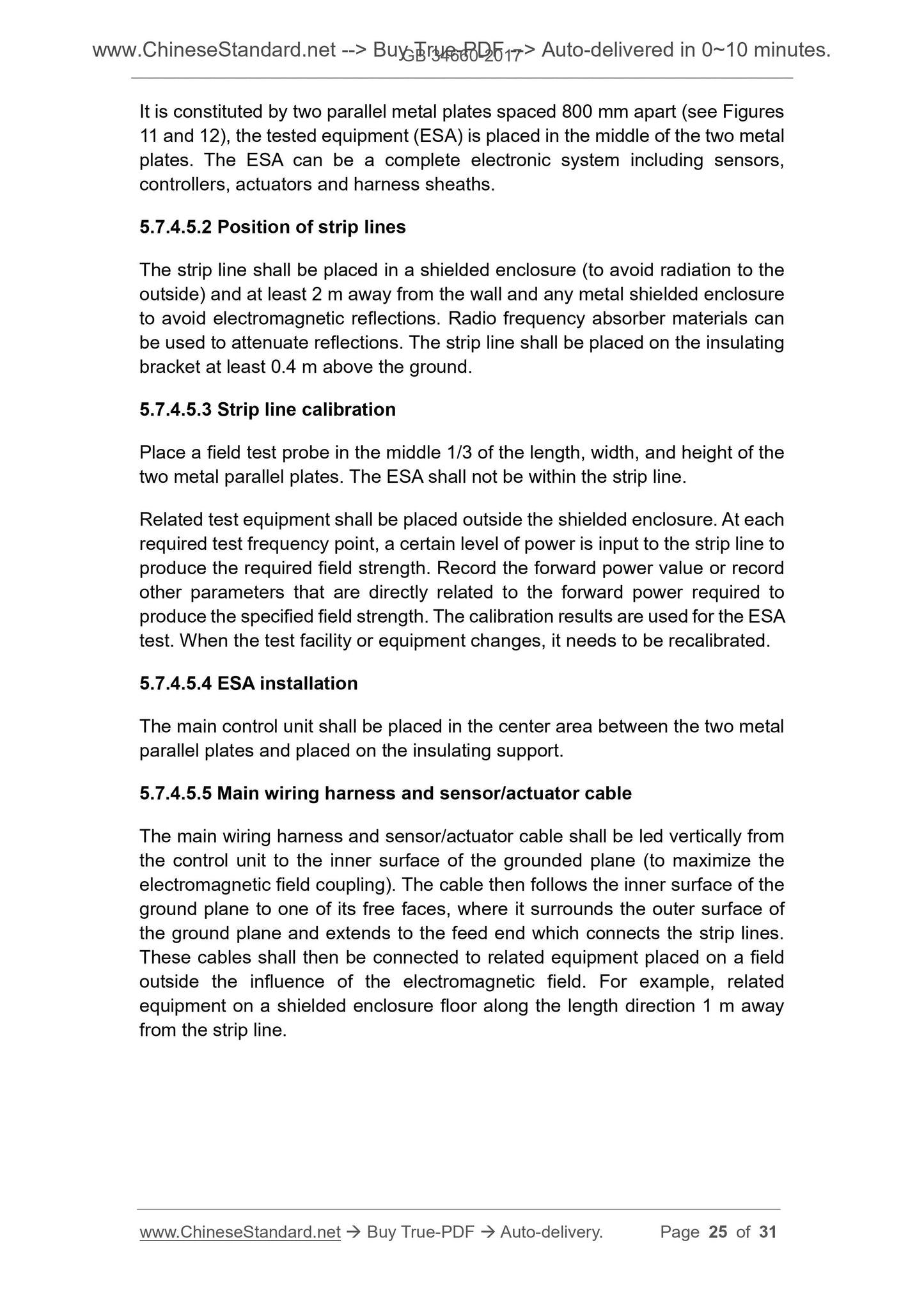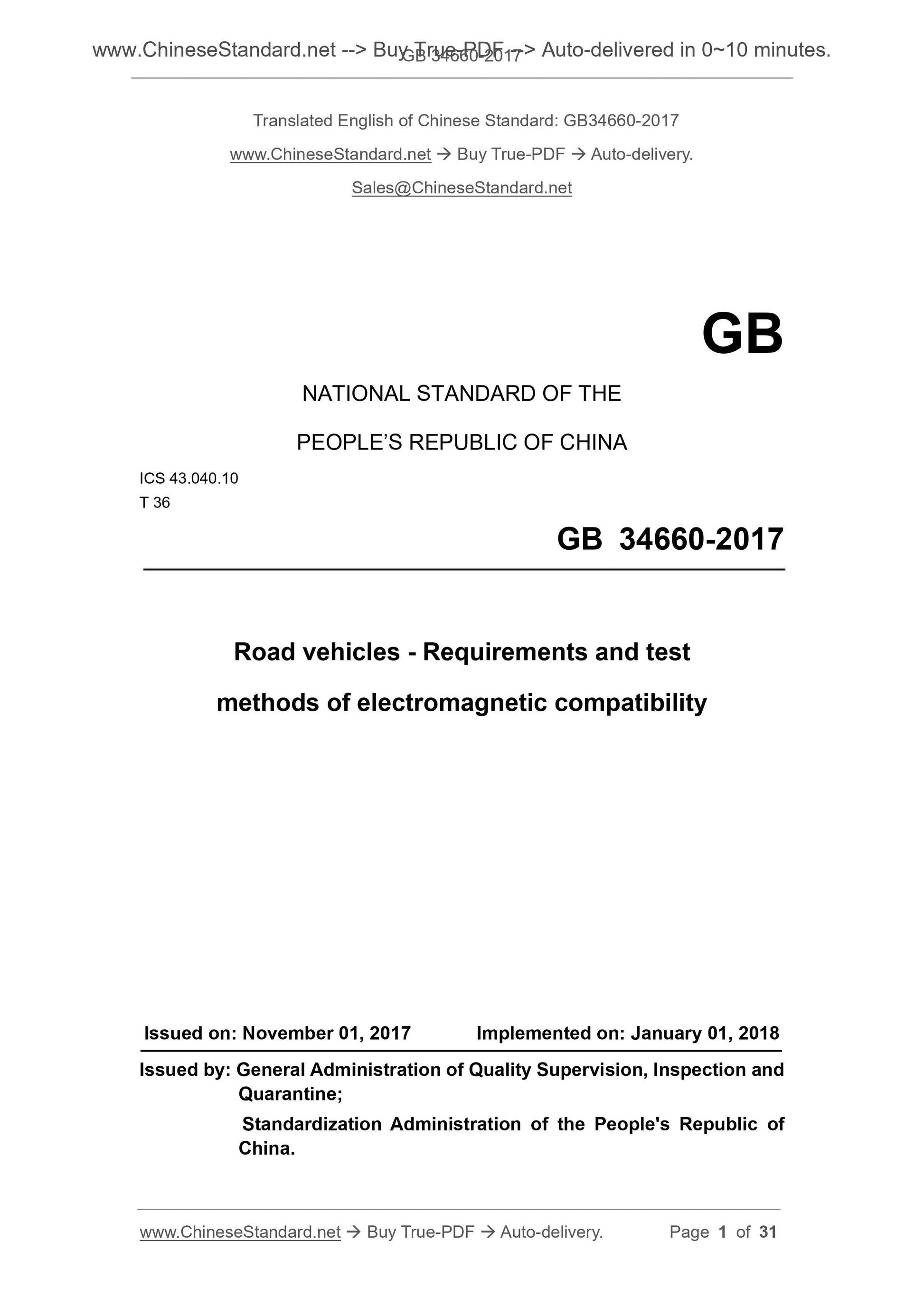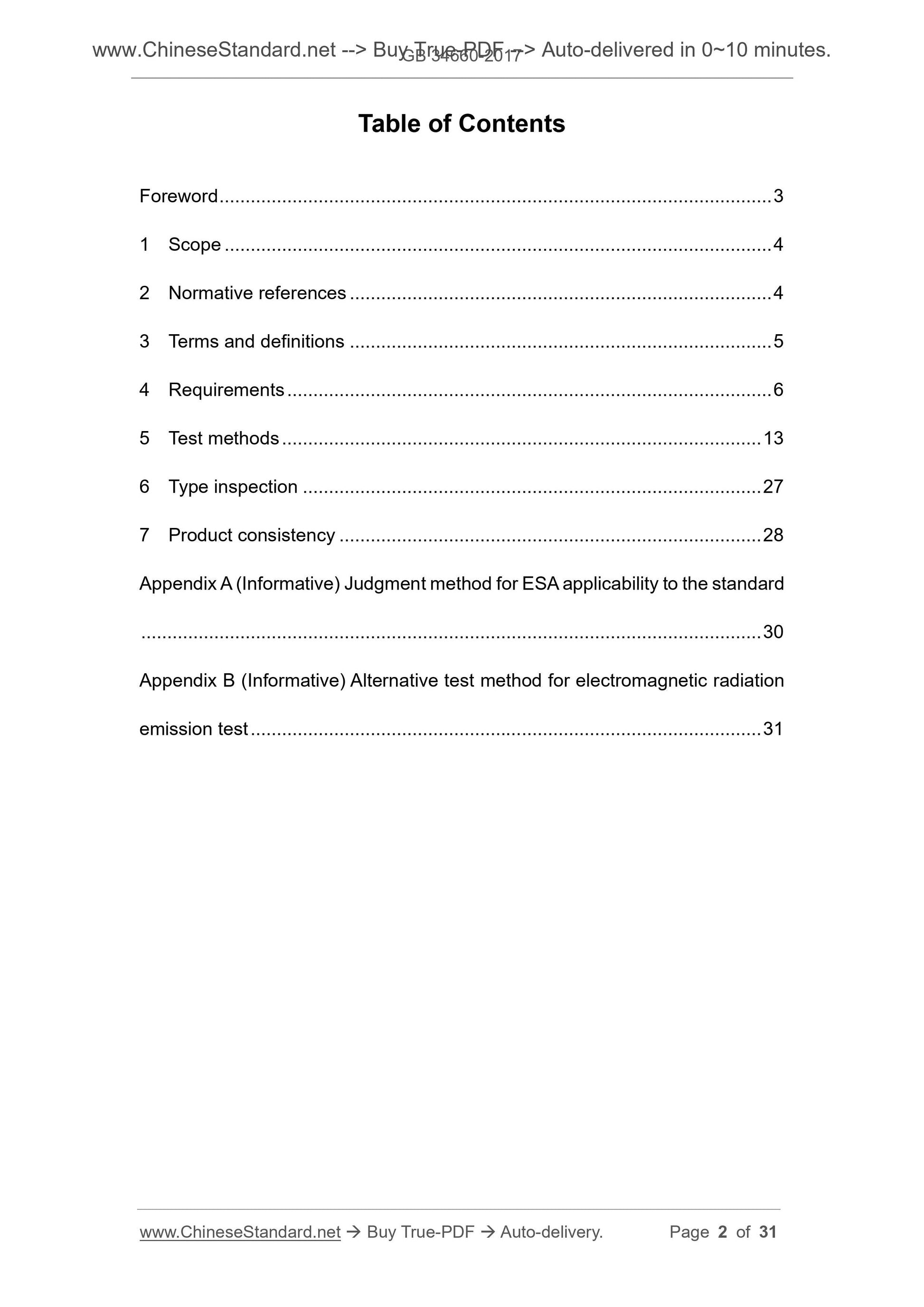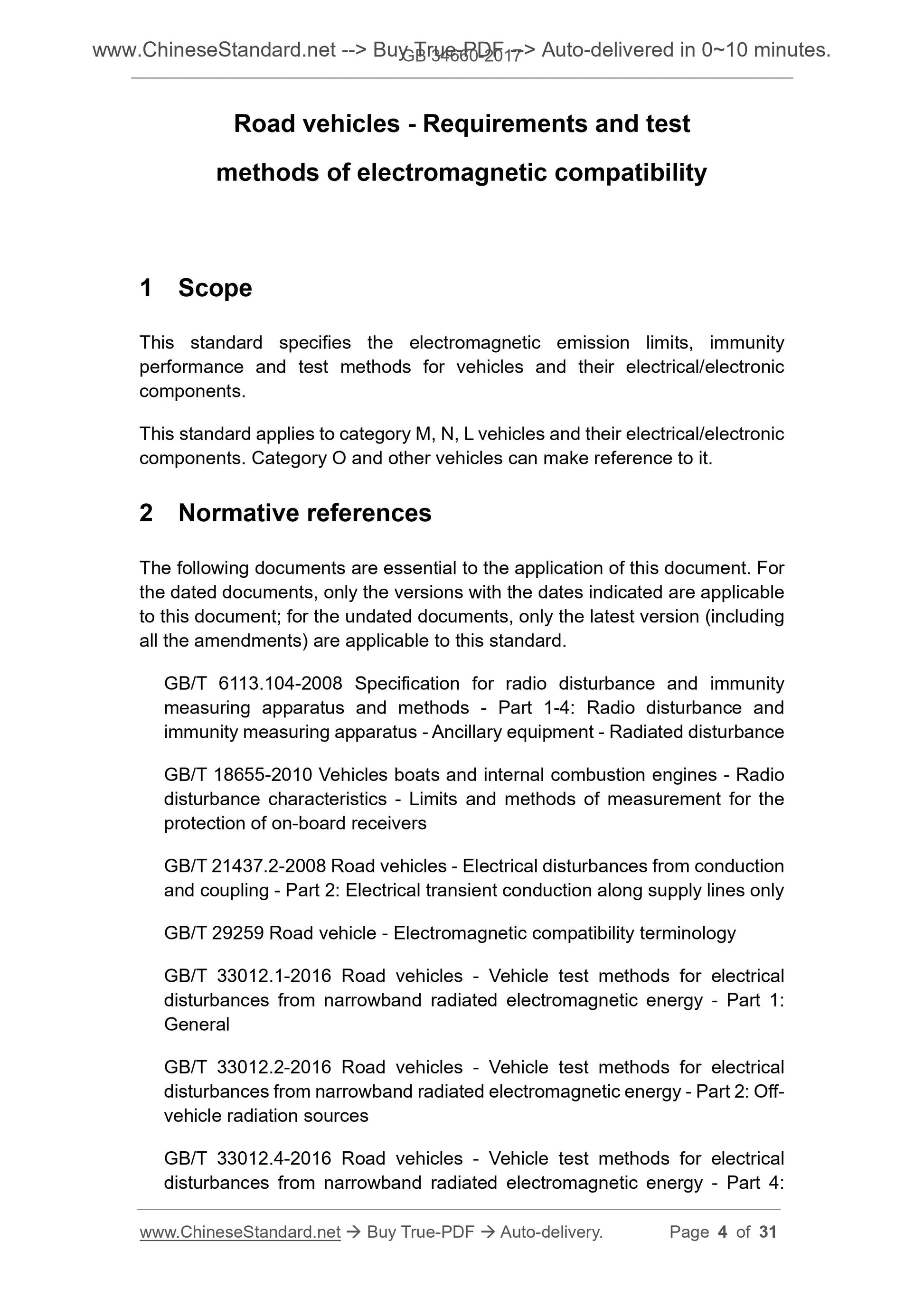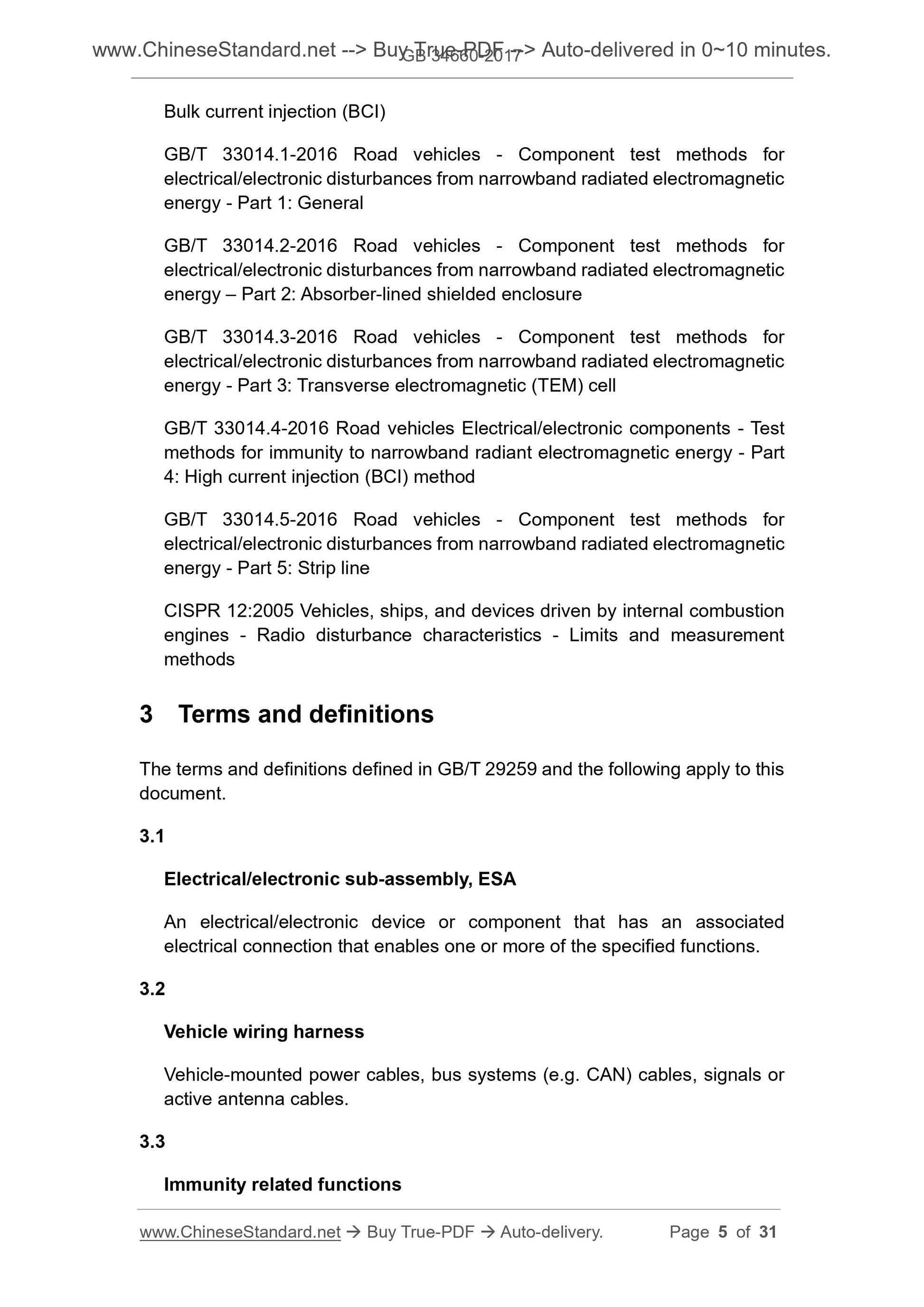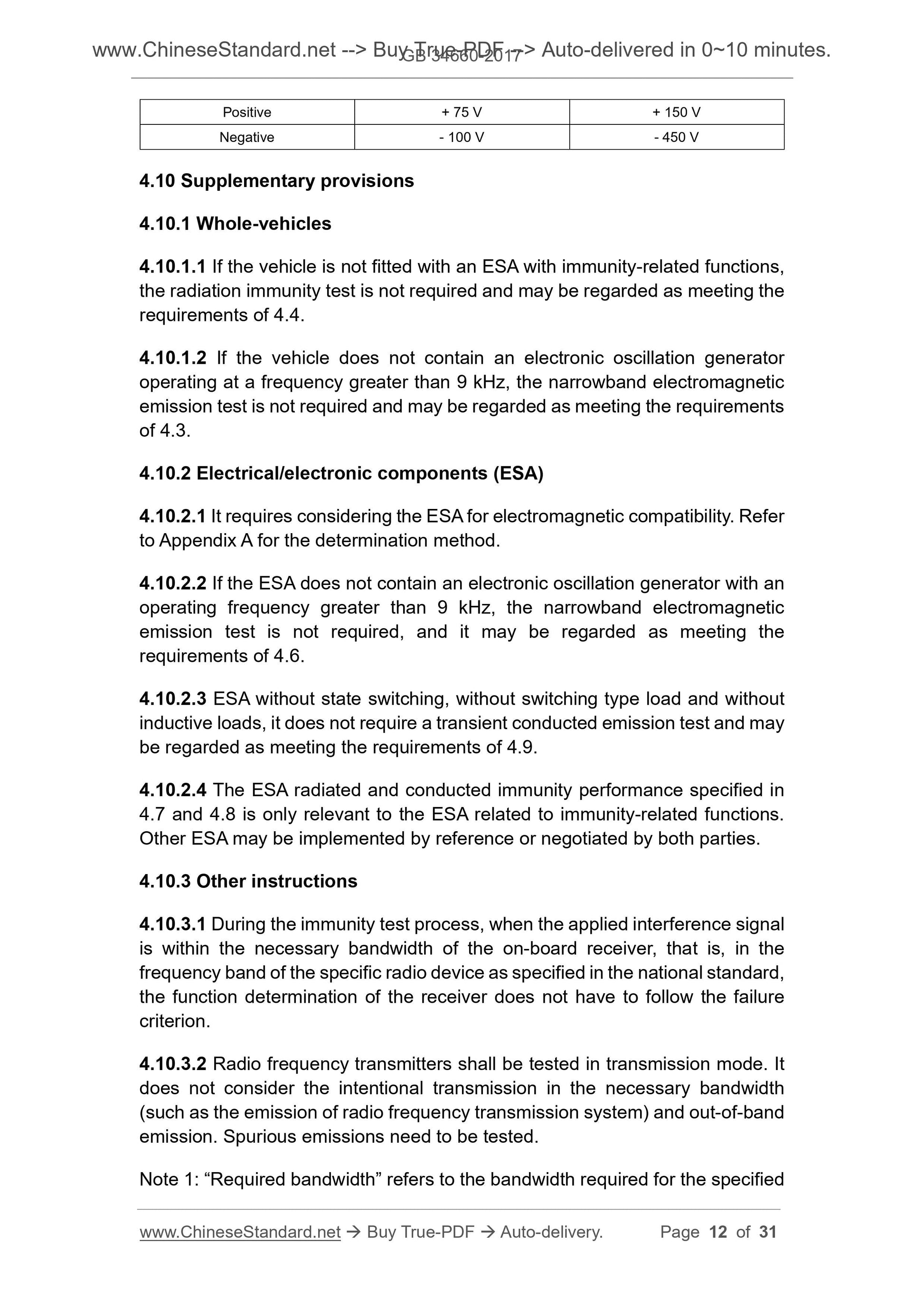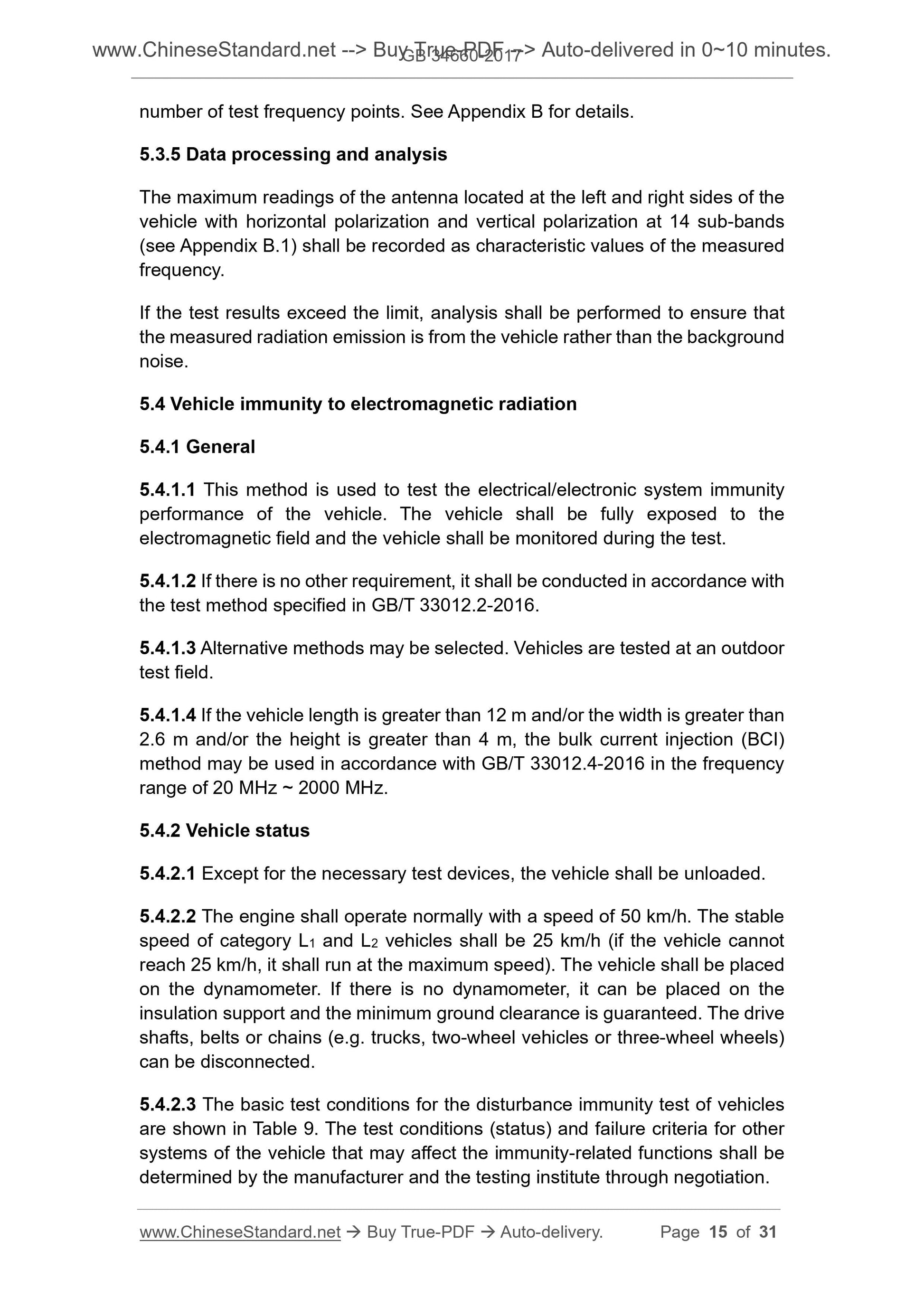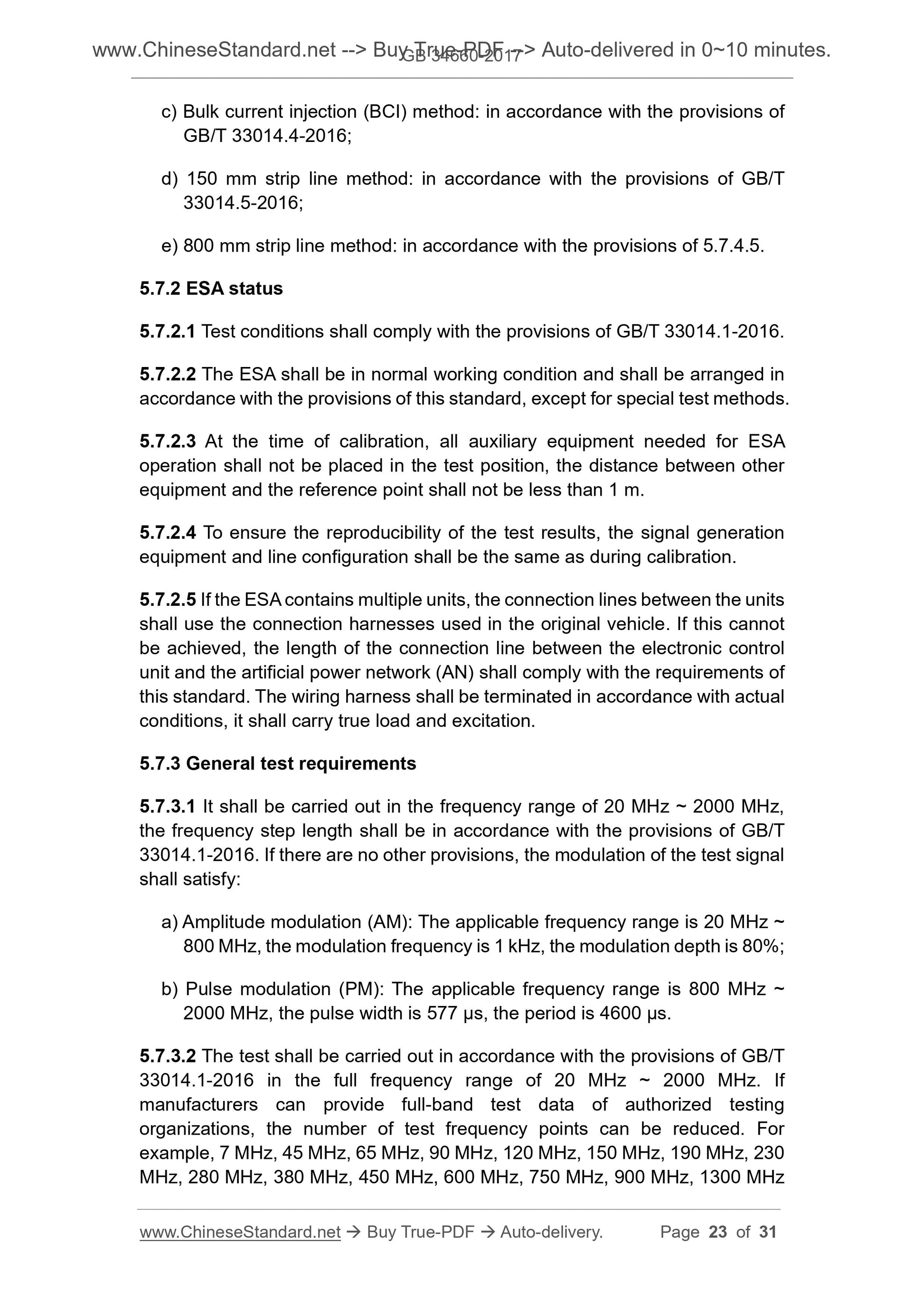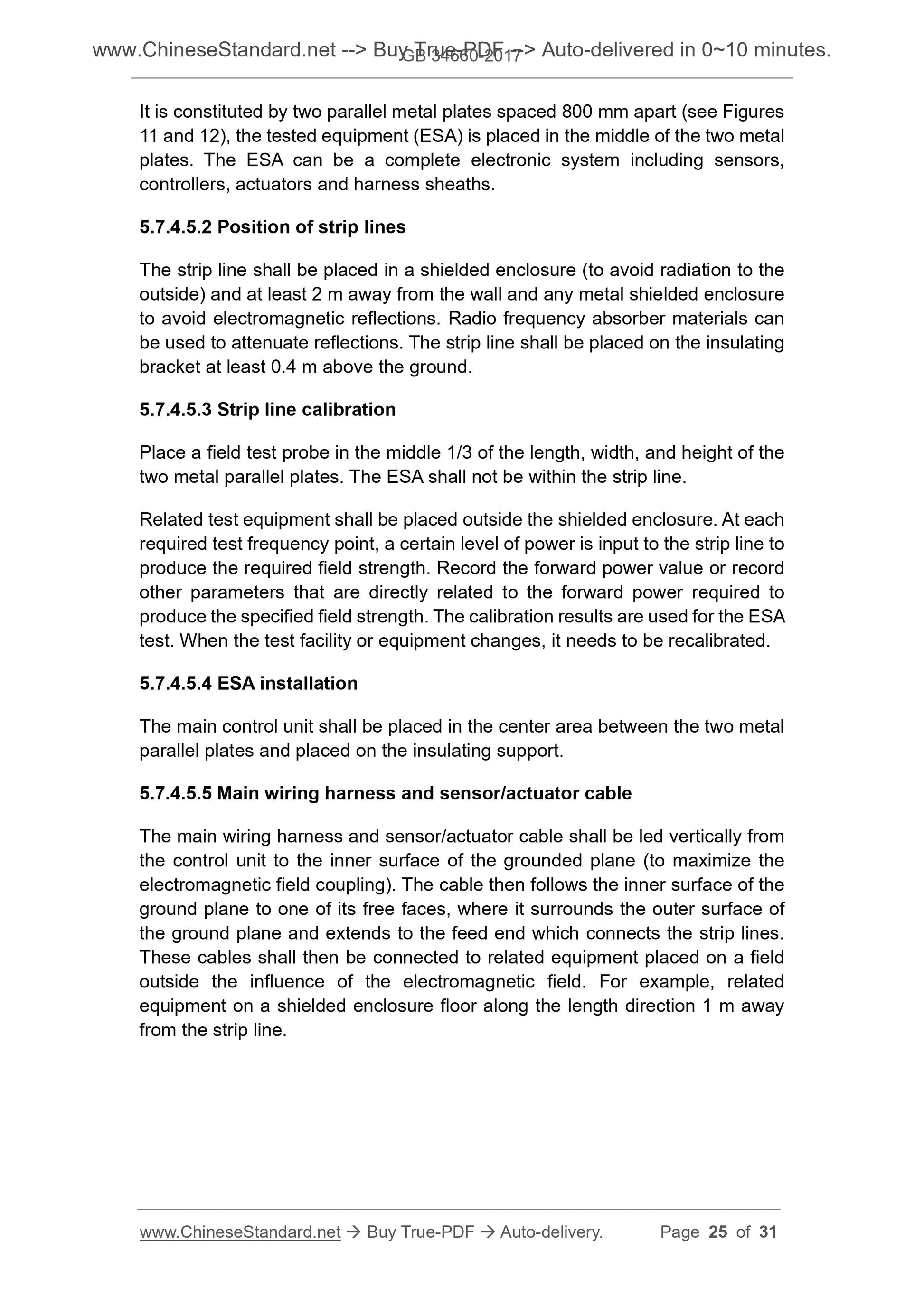1
/
of
8
PayPal, credit cards. Download editable-PDF & invoice in 1 second!
GB 34660-2017 English PDF
GB 34660-2017 English PDF
Regular price
$145.00 USD
Regular price
Sale price
$145.00 USD
Unit price
/
per
Shipping calculated at checkout.
Couldn't load pickup availability
Delivery: 3 seconds. Download true-PDF + Invoice.
Get QUOTATION in 1-minute: Click GB 34660-2017
Historical versions: GB 34660-2017
Preview True-PDF (Reload/Scroll if blank)
GB 34660-2017: Road vehicles -- Requirements and test methods of electromagnetic compatibility
GB 34660-2017
GB
NATIONAL STANDARD OF THE
PEOPLE’S REPUBLIC OF CHINA
ICS 43.040.10
T 36
Road vehicles - Requirements and test
methods of electromagnetic compatibility
ISSUED ON. NOVEMBER 01, 2017
IMPLEMENTED ON. JANUARY 01, 2018
Issued by. General Administration of Quality Supervision, Inspection and
Quarantine;
Standardization Administration of the People's Republic of
China.
Table of Contents
Foreword . 3
1 Scope .. 4
2 Normative references . 4
3 Terms and definitions . 5
4 Requirements . 6
5 Test methods . 13
6 Type inspection .. 27
7 Product consistency . 28
Appendix A (Informative) Judgment method for ESA applicability to the standard
. 30
Appendix B (Informative) Alternative test method for electromagnetic radiation
emission test . 31
Road vehicles - Requirements and test
methods of electromagnetic compatibility
1 Scope
This standard specifies the electromagnetic emission limits, immunity
performance and test methods for vehicles and their electrical/electronic
components.
This standard applies to category M, N, L vehicles and their electrical/electronic
components. Category O and other vehicles can make reference to it.
2 Normative references
The following documents are essential to the application of this document. For
the dated documents, only the versions with the dates indicated are applicable
to this document; for the undated documents, only the latest version (including
all the amendments) are applicable to this standard.
GB/T 6113.104-2008 Specification for radio disturbance and immunity
measuring apparatus and methods - Part 1-4. Radio disturbance and
immunity measuring apparatus - Ancillary equipment - Radiated disturbance
GB/T 18655-2010 Vehicles boats and internal combustion engines - Radio
disturbance characteristics - Limits and methods of measurement for the
protection of on-board receivers
GB/T 21437.2-2008 Road vehicles - Electrical disturbances from conduction
and coupling - Part 2. Electrical transient conduction along supply lines only
GB/T 29259 Road vehicle - Electromagnetic compatibility terminology
GB/T 33012.1-2016 Road vehicles - Vehicle test methods for electrical
disturbances from narrowband radiated electromagnetic energy - Part 1.
General
GB/T 33012.2-2016 Road vehicles - Vehicle test methods for electrical
disturbances from narrowband radiated electromagnetic energy - Part 2. Off-
vehicle radiation sources
GB/T 33012.4-2016 Road vehicles - Vehicle test methods for electrical
disturbances from narrowband radiated electromagnetic energy - Part 4.
Bulk current injection (BCI)
GB/T 33014.1-2016 Road vehicles - Component test methods for
electrical/electronic disturbances from narrowband radiated electromagnetic
energy - Part 1. General
GB/T 33014.2-2016 Road vehicles - Component test methods for
electrical/electronic disturbances from narrowband radiated electromagnetic
energy – Part 2. Absorber-lined shielded enclosure
GB/T 33014.3-2016 Road vehicles - Component test methods for
electrical/electronic disturbances from narrowband radiated electromagnetic
energy - Part 3. Transverse electromagnetic (TEM) cell
GB/T 33014.4-2016 Road vehicles Electrical/electronic components - Test
methods for immunity to narrowband radiant electromagnetic energy - Part
4. High current injection (BCI) method
GB/T 33014.5-2016 Road vehicles - Component test methods for
electrical/electronic disturbances from narrowband radiated electromagnetic
energy - Part 5. Strip line
CISPR 12.2005 Vehicles, ships, and devices driven by internal combustion
engines - Radio disturbance characteristics - Limits and measurement
methods
3 Terms and definitions
The terms and definitions defined in GB/T 29259 and the following apply to this
document.
3.1
Electrical/electronic sub-assembly, ESA
An electrical/electronic device or component that has an associated
electrical connection that enables one or more of the specified functions.
3.2
Vehicle wiring harness
Vehicle-mounted power cables, bus systems (e.g. CAN) cables, signals or
active antenna cables.
3.3
Immunity related functions
Positive + 75 V + 150 V
Negative - 100 V - 450 V
4.10 Supplementary provisions
4.10.1 Whole-vehicles
4.10.1.1 If the vehicle is not fitted with an ESA with immunity-related functions,
the radiation immunity test is not required and may be regarded as meeting the
requirements of 4.4.
4.10.1.2 If the vehicle does not contain an electronic oscillation generator
operating at a frequency greater than 9 kHz, the narrowband electromagnetic
emission test is not required and may be regarded as meeting the requirements
of 4.3.
4.10.2 Electrical/electronic components (ESA)
4.10.2.1 It requires considering the ESA for electromagnetic compatibility. Refer
to Appendix A for the determination method.
4.10.2.2 If the ESA does not contain an electronic oscillation generator with an
operating frequency greater than 9 kHz, the narrowband electromagnetic
emission test is not required, and it may be regarded as meeting the
requirements of 4.6.
4.10.2.3 ESA without state switching, without switching type load and without
inductive loads, it does not require a transient conducted emission test and may
be regarded as meeting the requirements of 4.9.
4.10.2.4 The ESA radiated and conducted immunity performance specified in
4.7 and 4.8 is only relevant to the ESA related to immunity-related functions.
Other ESA may be implemented by reference or negotiated by both parties.
4.10.3 Other instructions
4.10.3.1 During the immunity test process, when the applied interference signal
is within the necessary bandwidth of the on-board receiver, that is, in the
frequency band of the specific radio device as specified in the national standard,
the function determination of the receiver does not have to follow the failure
criterion.
4.10.3.2 Radio frequency transmitters shall be tested in transmission mode. It
does not consider the intentional transmission in the necessary bandwidth
(such as the emission of radio frequency transmission system) and out-of-band
emission. Spurious emissions need to be tested.
Note 1. “Required bandwidth” refers to the bandwidth required for the specified
number of test frequency points. See Appendix B for details.
5.3.5 Data processing and analysis
The maximum readings of the antenna located at the left and right sides of the
vehicle with horizontal polarization and vertical polarization at 14 sub-bands
(see Appendix B.1) shall be recorded as characteristic values of the measured
frequency.
If the test results exceed the limit, analysis shall be performed to ensure that
the measured radiation emission is from the vehicle rather than the background
noise.
5.4 Vehicle immunity to electromagnetic radiation
5.4.1 General
5.4.1.1 This method is used to test the electrical/electronic system immunity
performance of the vehicle. The vehicle shall be fully exposed to the
electromagnetic field and the vehicle shall be monitored during the test.
5.4.1.2 If there is no other requirement, it shall be conducted in accordance with
the test method specified in GB/T 33012.2-2016.
5.4.1.3 Alternative methods may be selected. Vehicles are tested at an outdoor
test field.
5.4.1.4 If the vehicle length is greater than 12 m and/or the width is greater than
2.6 m and/or the height is greater than...
Get QUOTATION in 1-minute: Click GB 34660-2017
Historical versions: GB 34660-2017
Preview True-PDF (Reload/Scroll if blank)
GB 34660-2017: Road vehicles -- Requirements and test methods of electromagnetic compatibility
GB 34660-2017
GB
NATIONAL STANDARD OF THE
PEOPLE’S REPUBLIC OF CHINA
ICS 43.040.10
T 36
Road vehicles - Requirements and test
methods of electromagnetic compatibility
ISSUED ON. NOVEMBER 01, 2017
IMPLEMENTED ON. JANUARY 01, 2018
Issued by. General Administration of Quality Supervision, Inspection and
Quarantine;
Standardization Administration of the People's Republic of
China.
Table of Contents
Foreword . 3
1 Scope .. 4
2 Normative references . 4
3 Terms and definitions . 5
4 Requirements . 6
5 Test methods . 13
6 Type inspection .. 27
7 Product consistency . 28
Appendix A (Informative) Judgment method for ESA applicability to the standard
. 30
Appendix B (Informative) Alternative test method for electromagnetic radiation
emission test . 31
Road vehicles - Requirements and test
methods of electromagnetic compatibility
1 Scope
This standard specifies the electromagnetic emission limits, immunity
performance and test methods for vehicles and their electrical/electronic
components.
This standard applies to category M, N, L vehicles and their electrical/electronic
components. Category O and other vehicles can make reference to it.
2 Normative references
The following documents are essential to the application of this document. For
the dated documents, only the versions with the dates indicated are applicable
to this document; for the undated documents, only the latest version (including
all the amendments) are applicable to this standard.
GB/T 6113.104-2008 Specification for radio disturbance and immunity
measuring apparatus and methods - Part 1-4. Radio disturbance and
immunity measuring apparatus - Ancillary equipment - Radiated disturbance
GB/T 18655-2010 Vehicles boats and internal combustion engines - Radio
disturbance characteristics - Limits and methods of measurement for the
protection of on-board receivers
GB/T 21437.2-2008 Road vehicles - Electrical disturbances from conduction
and coupling - Part 2. Electrical transient conduction along supply lines only
GB/T 29259 Road vehicle - Electromagnetic compatibility terminology
GB/T 33012.1-2016 Road vehicles - Vehicle test methods for electrical
disturbances from narrowband radiated electromagnetic energy - Part 1.
General
GB/T 33012.2-2016 Road vehicles - Vehicle test methods for electrical
disturbances from narrowband radiated electromagnetic energy - Part 2. Off-
vehicle radiation sources
GB/T 33012.4-2016 Road vehicles - Vehicle test methods for electrical
disturbances from narrowband radiated electromagnetic energy - Part 4.
Bulk current injection (BCI)
GB/T 33014.1-2016 Road vehicles - Component test methods for
electrical/electronic disturbances from narrowband radiated electromagnetic
energy - Part 1. General
GB/T 33014.2-2016 Road vehicles - Component test methods for
electrical/electronic disturbances from narrowband radiated electromagnetic
energy – Part 2. Absorber-lined shielded enclosure
GB/T 33014.3-2016 Road vehicles - Component test methods for
electrical/electronic disturbances from narrowband radiated electromagnetic
energy - Part 3. Transverse electromagnetic (TEM) cell
GB/T 33014.4-2016 Road vehicles Electrical/electronic components - Test
methods for immunity to narrowband radiant electromagnetic energy - Part
4. High current injection (BCI) method
GB/T 33014.5-2016 Road vehicles - Component test methods for
electrical/electronic disturbances from narrowband radiated electromagnetic
energy - Part 5. Strip line
CISPR 12.2005 Vehicles, ships, and devices driven by internal combustion
engines - Radio disturbance characteristics - Limits and measurement
methods
3 Terms and definitions
The terms and definitions defined in GB/T 29259 and the following apply to this
document.
3.1
Electrical/electronic sub-assembly, ESA
An electrical/electronic device or component that has an associated
electrical connection that enables one or more of the specified functions.
3.2
Vehicle wiring harness
Vehicle-mounted power cables, bus systems (e.g. CAN) cables, signals or
active antenna cables.
3.3
Immunity related functions
Positive + 75 V + 150 V
Negative - 100 V - 450 V
4.10 Supplementary provisions
4.10.1 Whole-vehicles
4.10.1.1 If the vehicle is not fitted with an ESA with immunity-related functions,
the radiation immunity test is not required and may be regarded as meeting the
requirements of 4.4.
4.10.1.2 If the vehicle does not contain an electronic oscillation generator
operating at a frequency greater than 9 kHz, the narrowband electromagnetic
emission test is not required and may be regarded as meeting the requirements
of 4.3.
4.10.2 Electrical/electronic components (ESA)
4.10.2.1 It requires considering the ESA for electromagnetic compatibility. Refer
to Appendix A for the determination method.
4.10.2.2 If the ESA does not contain an electronic oscillation generator with an
operating frequency greater than 9 kHz, the narrowband electromagnetic
emission test is not required, and it may be regarded as meeting the
requirements of 4.6.
4.10.2.3 ESA without state switching, without switching type load and without
inductive loads, it does not require a transient conducted emission test and may
be regarded as meeting the requirements of 4.9.
4.10.2.4 The ESA radiated and conducted immunity performance specified in
4.7 and 4.8 is only relevant to the ESA related to immunity-related functions.
Other ESA may be implemented by reference or negotiated by both parties.
4.10.3 Other instructions
4.10.3.1 During the immunity test process, when the applied interference signal
is within the necessary bandwidth of the on-board receiver, that is, in the
frequency band of the specific radio device as specified in the national standard,
the function determination of the receiver does not have to follow the failure
criterion.
4.10.3.2 Radio frequency transmitters shall be tested in transmission mode. It
does not consider the intentional transmission in the necessary bandwidth
(such as the emission of radio frequency transmission system) and out-of-band
emission. Spurious emissions need to be tested.
Note 1. “Required bandwidth” refers to the bandwidth required for the specified
number of test frequency points. See Appendix B for details.
5.3.5 Data processing and analysis
The maximum readings of the antenna located at the left and right sides of the
vehicle with horizontal polarization and vertical polarization at 14 sub-bands
(see Appendix B.1) shall be recorded as characteristic values of the measured
frequency.
If the test results exceed the limit, analysis shall be performed to ensure that
the measured radiation emission is from the vehicle rather than the background
noise.
5.4 Vehicle immunity to electromagnetic radiation
5.4.1 General
5.4.1.1 This method is used to test the electrical/electronic system immunity
performance of the vehicle. The vehicle shall be fully exposed to the
electromagnetic field and the vehicle shall be monitored during the test.
5.4.1.2 If there is no other requirement, it shall be conducted in accordance with
the test method specified in GB/T 33012.2-2016.
5.4.1.3 Alternative methods may be selected. Vehicles are tested at an outdoor
test field.
5.4.1.4 If the vehicle length is greater than 12 m and/or the width is greater than
2.6 m and/or the height is greater than...
Share
